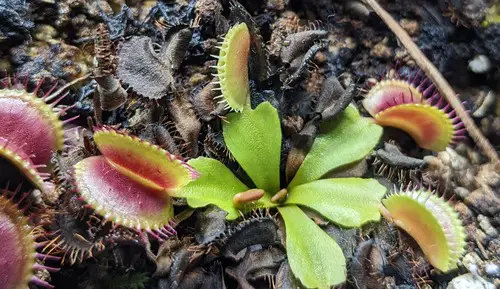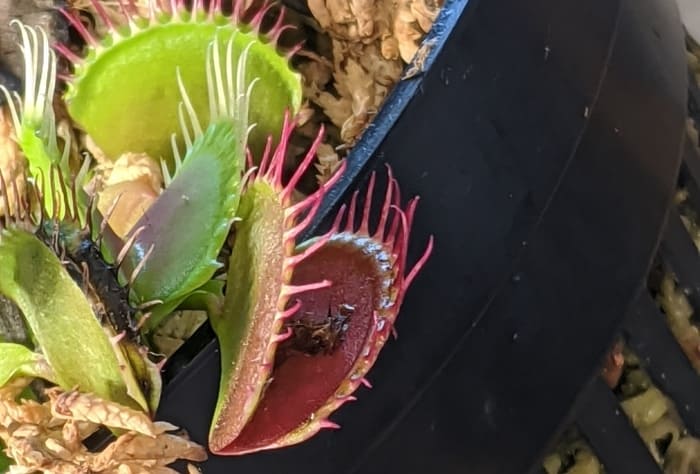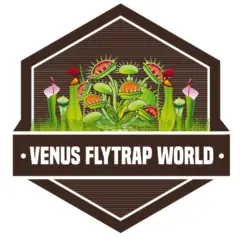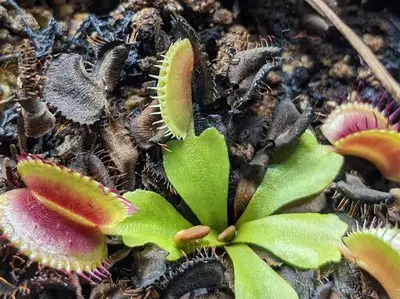The traps of a Venus fly trap will open and close through the plant’s life. However, occasionally, a leaf might remain close for an extended period. In this article, I will explain why a trap will not open and how to fix this in the future.
The traps in a Venus fly trap won’t open when the plant is digesting an insect, or the leaf might be at the end of its life. Improper feeding can cause the leaf to stay close and eventually die. Also, a leaf reaching the end of life early could be due to stress or unsuitable growing conditions.
Now, let’s explore in detail the main two reasons why Venus flytraps won’t open:
- The trap has reached the end of life
- The Venus fly trap is digesting a meal

The Leaf Has Reached End of Life
Each Venus fly trap plant has several leaves. One plant will usually have 3 to 8 leaves. Each of those leaves has a trap that can close and reopen multiple times. However, the number of times the trap can close is limited.
After the leaf has close a finite number of times, usually about five times, the leaf will reach the end of life.
A trap can dry up and die at any point due to age, but activating the leaf multiple times will exhaust the leaf and eventually kill it. Sometimes, it can be very beneficial for the plant to close. If the plant captures a bug, the benefit outweighs the negative side of potentially losing a leaf.
Venus fly trap leaves will reopen after 2-12 hours when triggered by something, but they do not consume prey.
A plant not digesting something will reopen shortly unless the leaf is exhausted and might remain closed and wither.
Here are some tips to avoid causing stress to your plant and losing leaves for no good reason.
- Avoid triggering the traps from your plant to close
- Do not cause stress by repotting often; a yearly repotting is enough
- Grow your plant far away from pets and people that might cause stress and play with the leaves
I do not worry when a leaf remains closed and starts to turn black. It is its natural process. However, you must keep an eye on and confirm that your plant is not losing all its leaves. This article can help you with info on black leaf prevention.
The Venus Fly Trap Is Digesting a Bug
In most cases, Venus fly traps will be closed because they are digesting an insect. Venus fly traps lure insects with their bright colors and the sweet nectar they produce inside their traps.
If a bug triggers the traps, the leaves will close (hopefully), capturing the prey.
Once a Venus fly trap captures an insect, the leaf will take some time to extract critical nutrients.
As a general rule, it takes 1-2 weeks for Venus fly traps to digest an insect after closing its trap. Larger insects will require up to three weeks to digest. After the plant extracts the nutrients, the leaf will reopen to capture more insects.
In most cases, Venus fly traps will capture insects and take a few weeks to dissolve the soft parts of the bug. Then, they reopen, exposing the remains of the prey. However, in some scenarios, the plant might remain closed for extended periods or lead to a black leaf.
These are some common causes why a leaf will stay closed:
- The Venus flytrap is digesting an insect that is too large in size
- The plat is eating human food
- The insect inside the trap is hard to digest

The Leaf Its Consuming a Large Bug
Venus fly traps are built to consume bugs that fit within their traps.
When a bug is too big, the plant cannot fully digest it. After extracting some nutrients, the leaf will eventually give up, stay shut, and start turning black.
As a general rule, when feeding a Venus fly trap, you must select an insect no larger than 2/3 of the size of the trap. Smaller insects work well too!
The Trap Is Consuming a Difficult-to-Digest Insect
Some insects are just more challenging to digest. Beetles with hard shells, for example, can cause some stress to the plant.
When a Venus fly trap cannot digest a specific bug due to its size and composition, it will often abandon the task and let the leaf wither.
To prevent this from happening, consider employing nutritious but soft bugs for easy digestion for feeding your plant. This guide contains a complete list of what to provide and not to feed your plant.
The Plant is Eating Unsuitable Food
Finally, another common mistake that can cause a leaf to stay close and die is using incorrect food.
Venus flytraps should never attempt to consume human food. Cheese, fruit, beef, chicken, candy, sausage, blood, or any human food is unsuitable for carnivorous plants. Venus fly traps won’t be able to break those foods down; the leaf will turn black and wither.
Leafs can stay shut with rotten food inside for long periods. I recommend cutting the leaf off and throwing it away. Rotting matter can attract mold and pests.
Feeding Venus Flytrap Tips
If you own a Venus flytrap, you might be interested in feeding it. You can find a short overview below and a complete guide here: Venus Fly Trap Feeding Guide with Photos.
When feeding a Venus flytrap, employ bugs that can fit inside a trap and drop the insect in between the trap’s lobes. They can consume dead or live prey, but feeding with dead prey adds complexity.
The feeding process is not too hard, but you must follow the instructions below to avoid harming your plant. For example, overfeeding can damage the plant.
Venus flytraps growing outdoors often capture their own food and do not need to be fed.
Generally, feed your Venus flytrap once every two to six weeks by dropping the bug inside the trap. Use a single bug and feed only one trap of the entire plant. The insect must be small enough to fit inside the trap.
To avoid losing leaves due to improper feeding, follow these tips:
- Outdoor Venus flytraps do not require feeding
- Feed your plant once every 2 to 6 weeks
- Only feed insects or spiders to your Venus Flytrap
- The insects must fit inside the trap
- Do not feed your plant during dormancy
- Baby Venus flytraps do not need to be fed


